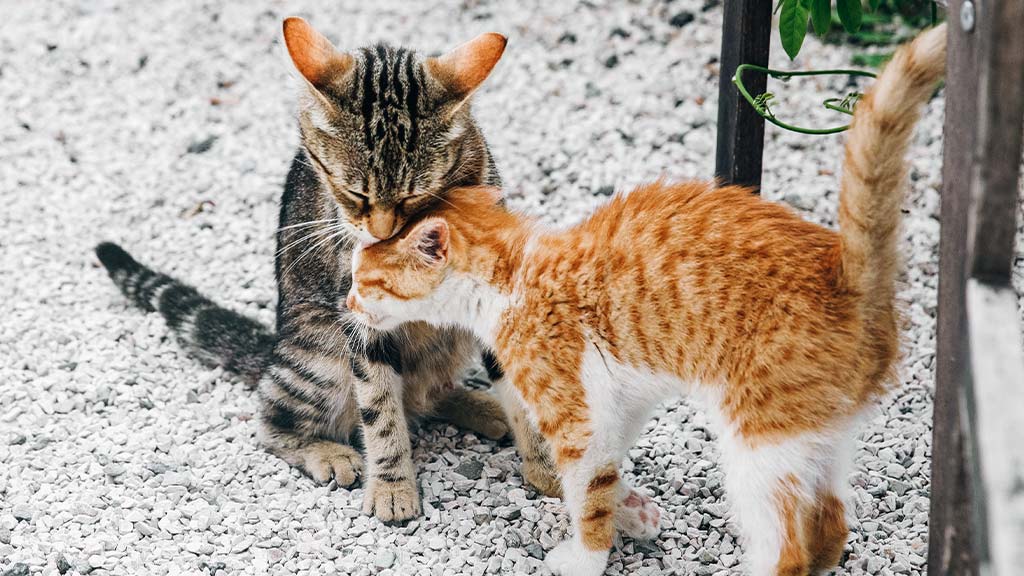Ever wondered what your cat’s slow blink or tail flick means? Let’s decode how cats communicate with each other — it’s way more than just meows and purrs.
The other day, I spotted two cats in Balboa Park, San Diego. They were making various sounds — chirps, meows, you name it. At one point, they started rubbing against each other like they were sharing some serious gossip. I couldn’t understand a thing, but it got me wondering: what were they discussing? And how do cats even communicate with each other?
That moment sparked in me to decode their secret language. Turns out, cats are genius at expressing themselves. They have a clear and well-organized “language system” consisting of peculiar sounds, subtle body movements, and mysterious actions including scent marking.
For example, a slow blink from a cat often means trust and affection. A flick of the tail can show irritation or excitement. Even the position of their ears or whiskers can reveal their mood. These small actions carry deep meaning and help cats understand each other.
So, how cats communicate with each other isn’t just random chaos – it’s actually fascinating. Learning it helps us understand their emotions better. When we focus on their signals, we can build a stronger bond with them. Plus, we can respond in ways that make sense to them, creating a happier relationship between cats and their humans.
The Science behind Cat Communication
Cats rely on instinctual and learned behaviors to communicate. They communicate using a mix of vocalizations, body language, and scent signals. Their meows, purrs, and chirps convey different emotions and needs. And, the most amazing part is that cats can perfectly tweak their vocal signals to match the situation. They can switch up the tone, pitch, and length of their sounds to make them extra meaningful. It’s like they’ve got their own soundboard for every situation.
For example, a short, high-pitched meow often signals a friendly greeting. Cats may use this when their owner returns home or when they want attention. In contrast, a loud, drawn-out meow usually signals urgency or distress. Cats often use this when they are hungry, trapped, or seeking help.
On the other hand, cats’ Body language shows more predictable patterns based on context. For example, a raised tail, often with a slight curve at the tip, indicates a friendly greeting, while a puffed-up tail signals fear or aggression.
Moreover, slow blinking is a form of trust-building since cats interpret prolonged eye contact as a threat. And, scent marking through cheek rubbing and urine spraying provides a chemical form of communication, helping cats establish territory and social bonds.
But, whatever it is – a vocal sound, a body gesture, or other expressive movement – the science behind cats’ communication is both complex and interesting. Understanding their communication methods can help owners respond appropriately to their cat’s needs.
How Cats Communicate with Other Animals
Cats interact and love to be in the company of humans and other animals. For this, they have learned different methods of interaction. But, have you ever thought about how cats communicate with other animals? Know that cats communicate with other animals using vocal cues, body language, and scent signals.
For example, when interacting with dogs, cats often rely on posture and tail movements. A confident cat may approach with a relaxed body and an upright tail, signaling curiosity. If threatened, a cat may hiss, arch its back, or flick its tail rapidly. These signals help set boundaries and prevent conflicts. Some cats and dogs learn to understand each other’s hints as time passes, developing a peaceful coexistence.
In addition, cats use their signature scent markings in communication with other cats and animals. They release pheromones through facial glands, paws, and urine to claim territory and signal familiarity. Also, cats may rub against other household pets to mix scents, forming a social bond.
In multi-cat homes, slow blinking and mutual grooming show trust and friendship. However, unfamiliar animals may trigger defensive behaviors like growling or swatting. Identifying these signals helps cat owners manage interactions with other animals and reduce stress.
Understanding How Cats Communicate | Vocalization | Body Language | Olfactory Communication
Vocal Signals of Cats and Their Meanings
- Meow — Cats use meows mainly for human interaction. A short, soft meow signals a greeting, while a loud, prolonged meow expresses demand, such as demanding food or attention. Kittens also meow to communicate with their mothers.
- Purr — Often associated with relaxation and contentment, purring also occurs when a cat feels stressed or in pain. Scientists believe purring at frequencies between 25-150 Hz may promote healing and reduce discomfort.
- Chirp/Trill — A rolling, high-pitched sound used for friendly interaction. Mother cats trill to call kittens, and adult cats use it to greet their owners or other familiar animals. It signals excitement and a desire for social contact.
- Hiss — A defensive sound accompanied by an arched back and bared teeth. Cats hiss when they feel threatened, scared, or cornered. It warns potential threats to back off before an attack.
- Growl — A deep, guttural sound signaling aggression or discomfort. Cats growl when they feel their territory is invaded or when they want to deter an opponent. If ignored, growling may escalate into swatting or biting.
- Yowl — A long, drawn-out vocalization used during mating, fights, or when a cat feels lonely or distressed. Unneutered cats yowl to attract mates, while others may do it to express pain or confusion, especially in older cats.
- Chatter — A rapid, clicking sound made while watching prey, such as birds through a window. Experts believe this expresses frustration or excitement and may be an instinctive hunting behavior.
- Scream — A high-pitched, intense sound usually heard during cat fights or mating. It signals extreme distress or pain and often comes before physical conflict.
- Murmur — A soft, rhythmic sound that falls between a purr and a trill. Cats use it to seek attention, express affection, or communicate comfort, often directed at their owners.
Cat Body Language Signals and Their Meanings
- Tail Upright with a Curved Tip — A friendly greeting signal. Cats use this posture to show they feel safe and comfortable.
- Puffed-Up Tail — A sign of fear or aggression. Cats fluff up their tail to appear larger when they feel threatened by another animal or a sudden change in their environment.
- Slow Blinking — A display of trust and affection. Cats slowly blink at humans and other animals to communicate relaxation and a non-threatening attitude.
- Dilated Pupils — A reaction to excitement, fear, or low light. Wide pupils indicate high alertness, playful energy, or sudden anxiety in response to stimuli.
- Ears Forward — A sign of curiosity and engagement. Cats position their ears forward when they are interested in something or focusing on a sound or movement.
- Ears Flattened (Airplane Ears) — A sign of fear, submission, or irritation. Cats lower their ears against their head when they feel anxious, defensive, or ready to lash out.
- Arched Back with Raised Fur — A defensive stance. Cats do this when feeling threatened, appearing larger to ward off a perceived danger.
- Rolling Over and Showing Belly — A sign of trust or playfulness. However, this does not always invite belly rubs; some cats react defensively if touched.
- Twitching or Flicking Tail — A sign of irritation or overstimulation. Cats flick their tail when they are mildly annoyed or ready to act, such as when hunting.
- Wagging or Thumping Tail — A warning signal. Unlike dogs, a cat’s strong tail wag usually means they are agitated and might react aggressively if provoked.
- Crouching with Tensed Muscles — A hunting or defensive posture. Cats lower their body and prepare to pounce when stalking prey or bracing for an escape from danger.
- Lifting One Paw — A sign of indecision or mild curiosity. Cats may lift a paw when assessing a situation, unsure whether to approach or retreat.
- Whiskers Pushed Forward — A sign of excitement or interest. Cats extend their whiskers when hunting, exploring, or focusing on something intriguing.
- Whiskers Pulled Back — A reaction to fear or stress. Cats retract their whiskers when they feel nervous or want to avoid confrontation.
Cat Scent Signals and Their Meanings
- Cheek Rubbing (Facial Pheromones) — A sign of marking territory and showing affection. Cats rub their cheeks on objects, people, or other animals to leave pheromones that create a familiar and comforting scent. This behavior helps them claim spaces and bond with trusted individuals.
- Head Bunting (Head Bumping) — A friendly social gesture. When a cat bumps its head against a person or another pet, it transfers scent to reinforce trust and group identity. It is a sign of affection and social bonding.
- Paw Kneading (Sweat Gland Marking) — A comfort-seeking action. Cats mark their territory by kneading, releasing paw pad scent. This behavior originates from kittenhood when kneading helped stimulate milk flow from their mother.
- Body Rubbing (Full-Body Contact) — A sign of ownership and familiarity. When a cat rubs its entire body against an object, person, or another pet, it spreads its scent to claim them as part of its territory. This behavior also helps establish social bonds.
- Urine Spraying (Territorial Marking) — A warning signal to other animals. Cats spray urine on vertical surfaces to mark their territory, especially in response to unfamiliar scents, rival cats, or stress. Intact males spray more frequently, but spayed and neutered cats may also spray if they feel threatened.
- Fecal Marking (Middening) — A less common territorial signal. Some cats leave uncovered feces in visible areas to assert dominance and warn other animals to stay away. This behavior is more common in outdoor or feral cats.
- Scratching (Scent Glands in Paws) — A dual-purpose behavior. Cats scratch surfaces to remove old claw sheaths and leave scent markings through glands in their paw pads. This communicates presence and territory ownership to other animals.
- Tail Gland Marking (Supracaudal Gland) — A subtle but important scent signal. Cats have scent glands at the base of their tail, which they use to mark areas or individuals by rubbing against them. Some intact males produce stronger scents from this gland, often linked to mating behavior.
- Milk-Scented Pheromones (Mother-Kitten Bonding) — A calming and bonding mechanism. Mother cats release specific pheromones to comfort and guide their kittens, reinforcing their sense of security. Synthetic versions of these pheromones, like Feliway, help reduce stress in cats.
- Scent Investigating (Sniffing Other Animals or Objects) — A way to gather information. Cats rely on their sense of smell to understand their environment, detect other animals’ presence, and assess new objects. They may sniff another cat’s face or rear as a form of social recognition.
Final Words!
Cats communicate through a complex system of vocal cues, body language, and scent signals. Their meows, purrs, and chirps serve different purposes, from seeking attention to expressing excitement. Tail positions, ear movements, and whisker adjustments reveal their emotions, while scent marking plays a key role in territorial claims and social bonding.
Focusing on vocal tones, body postures, and scent-marking behaviors helps prevent misunderstandings and reduce stress. Learning cat signals helps owners understand and train their cats better and bond with them.
The next time your cat blinks at you, or flicks its tail, or rubs its cheek against you, recognize it as part of their intricate language. Master this knowledge to respond better, ensuring a happier and more thriving human-cat friendship.
Author
-

Cynthia Oluchi is a DVM. She combines her veterinary expertise with storytelling to help pet brands connect emotionally with their audience. With a unique blend of veterinary insight and storytelling, she helps pet businesses increase engagement, boost sales, and build lasting customer loyalty.
View all posts

